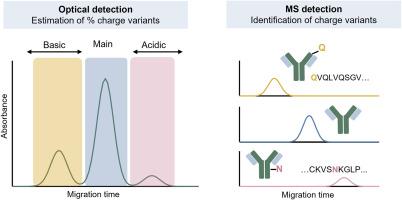利用纳流式鞘液毛细管电泳-质谱法表征近原生分离条件下的单克隆抗体电荷变体
IF 5.7
2区 化学
Q1 CHEMISTRY, ANALYTICAL
引用次数: 0
摘要
背景单克隆抗体(mAbs)在生产和储存过程中会发生多种翻译后修饰(PTMs),例如产生电荷和氧化变体。为确保蛋白质的质量和安全性,需要将 PTM 作为关键质量属性进行评估。毛细管区带电泳(CZE)可实现高效的电荷分离。He 等人(2011 年)开发的 CZE 方法目前已在制药行业常规应用,用于分析 mAbs 的电荷异质性。结果本研究提出了一种 CZE-UV/MS 方法,该方法使用羟丙基甲基纤维素的中性静态毛细管涂层,结合 pH 值为 5.0 的挥发性 BGE,实现了与 MS 兼容的 mAb 电荷变体分离。使用一组市售 mAb 研究了多个参数对分离性能的影响,包括 pH 值和 BGE 浓度、外加电压和注入的 mAb 浓度。使用不同 pI(7.4-9.2)和异质性程度的 IgG1 和 IgG4 mAb 对优化方法进行了评估。碱性和酸性变体用氢氧化铵调节 pH 值为 5.0 的 50 mM 乙酸 BGE 从母体 mAb 中分离出来。用新方法测定的电荷变体的相对丰度与用 He 等人的方法测定的相对丰度有很好的相关性。CZE-MS 耦合是用 nanoCEasy(一种低流量鞘液界面)完成的,它可以鉴定和定量检测 mAb 的碱性、酸性和不完全焦谷氨酸变体以及糖型。本文章由计算机程序翻译,如有差异,请以英文原文为准。


Characterization of monoclonal antibody charge variants under near-native separation conditions using nanoflow sheath liquid capillary electrophoresis-mass spectrometry
Background
Monoclonal antibodies (mAbs) undergo multiple post-translational modifications (PTMs) during production and storage, resulting for instance in charge and oxidized variants. PTMs need to be assessed as critical quality attributes to assure protein quality and safety. Capillary zone electrophoresis (CZE) enables efficient charge-based separation. The CZE method developed by He et al. (2011) is currently applied routinely in the pharmaceutical industry for profiling charge heterogeneity of mAbs. However, as the method relies on a non-volatile background electrolyte (BGE), it cannot be directly hyphenated with mass spectrometry (MS), hampering the identification of separated charge variants.
Results
This study presents a CZE-UV/MS method using a neutral static capillary coating of hydroxypropyl methylcellulose combined with a volatile BGE at pH 5.0 to allow for MS-compatible mAb charge variant separations. The effect of several parameters, including pH and concentration of the BGE, applied voltage, and injected mAb concentrations on separation performance was investigated using a panel of commercially available mAbs. The optimized method was evaluated with IgG1 and IgG4 mAbs of varying pI (7.4–9.2) and degrees of heterogeneity. Basic and acidic variants were separated from the parent mAb using a BGE of 50 mM acetic acid adjusted to pH 5.0 with ammonium hydroxide. The relative abundances of charge variants determined with the new method showed a good correlation with the corresponding relative levels obtained with the method of He et al. CZE-MS coupling was accomplished using the nanoCEasy, a low-flow sheath liquid interface, which enabled the identification and quantitation of basic, acidic, and incomplete pyroglutamate variants, and glycoforms of the tested mAbs.
Significance
This manuscript describes a new CZE-MS method that permits heterogeneity assessment of mAbs under MS-compatible conditions, providing charge variant separation.
求助全文
通过发布文献求助,成功后即可免费获取论文全文。
去求助
来源期刊

Analytica Chimica Acta
化学-分析化学
CiteScore
10.40
自引率
6.50%
发文量
1081
审稿时长
38 days
期刊介绍:
Analytica Chimica Acta has an open access mirror journal Analytica Chimica Acta: X, sharing the same aims and scope, editorial team, submission system and rigorous peer review.
Analytica Chimica Acta provides a forum for the rapid publication of original research, and critical, comprehensive reviews dealing with all aspects of fundamental and applied modern analytical chemistry. The journal welcomes the submission of research papers which report studies concerning the development of new and significant analytical methodologies. In determining the suitability of submitted articles for publication, particular scrutiny will be placed on the degree of novelty and impact of the research and the extent to which it adds to the existing body of knowledge in analytical chemistry.
 求助内容:
求助内容: 应助结果提醒方式:
应助结果提醒方式:


